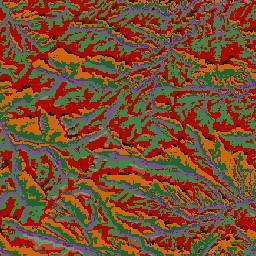
- Доступность набора данных
- 2006-01-24T00:00:00Z–2011-05-13T00:00:00Z
- Поставщик наборов данных
- Партнеры по науке сохранения природы
- Теги
Описание
Набор данных ALOS Landform содержит классы рельефа, созданные путём объединения наборов данных индекса непрерывной тепловой и инсоляции (CHILI) и многомасштабного индекса топографического положения (mTPI). Он основан на 10-метровой цифровой модели рельефа NED Геологической службы США (доступной в Восточной Европе как USGS/NED).
Наборы данных по экологически релевантной геоморфологии (ERGo), формам рельефа и физиографии, разработанные Conservation Science Partners (CSP), содержат подробные многомасштабные данные о формах рельефа и физиографических (т.н. «фасетных» характеристиках рельефа). Несмотря на множество потенциальных применений этих данных, изначальной целью их создания была разработка экологически релевантной классификации и карты форм рельефа и физиографических классов, подходящих для планирования адаптации к изменению климата. В связи с высокой неопределенностью, связанной с будущими климатическими условиями, и еще большей неопределенностью, связанной с экологическими реакциями, предоставление информации о том, что вряд ли изменится, дает руководителям надежную основу для разработки надежных планов адаптации к изменению климата. Количественная оценка этих характеристик ландшафта чувствительна к разрешению, поэтому мы предоставляем максимально возможное разрешение с учетом масштаба и характеристик данного индекса.
Группы
Размер пикселя
10 метров
Группы
| Имя | Размер пикселя | Описание |
|---|---|---|
constant | метров | Классы рельефа, полученные с помощью NED |
константа Таблица классов
| Ценить | Цвет | Описание |
|---|---|---|
| 11 | #141414 | Пик/гребень (теплый) |
| 12 | #383838 | Пик/гребень |
| 13 | #808080 | Пик/гребень (крутой) |
| 14 | #ebeb8f | Гора/водораздел |
| 15 | #f7d311 | Утес |
| 21 | #aa0000 | Верхний склон (теплый) |
| 22 | #d89382 | Верхний склон |
| 23 | #ddc9c9 | Верхний склон (крутой) |
| 24 | #dccdce | Верхний склон (плоский) |
| 31 | #1c6330 | Нижний склон (теплый) |
| 32 | #68aa63 | Нижний склон |
| 33 | #b5c98e | Нижний склон (крутой) |
| 34 | #e1f0e5 | Нижний склон (плоский) |
| 41 | #a975ba | Долина |
| 42 | #6f198c | Долина (узкая) |
Условия эксплуатации
Условия эксплуатации
Цитаты
Теобальд, Д.М., Харрисон-Атлас, Д., Монахан, У.Б., и Альбано, К.М. (2015). Экологически значимые карты рельефа и физико-географического разнообразия для планирования адаптации к изменению климата. PloS one, 10(12), e0143619
Исследуйте с Earth Engine
Редактор кода (JavaScript)
var dataset = ee.Image('CSP/ERGo/1_0/US/landforms'); var landforms = dataset.select('constant'); var landformsVis = { min: 11.0, max: 42.0, palette: [ '141414', '383838', '808080', 'ebeb8f', 'f7d311', 'aa0000', 'd89382', 'ddc9c9', 'dccdce', '1c6330', '68aa63', 'b5c98e', 'e1f0e5', 'a975ba', '6f198c' ], }; Map.setCenter(-105.58, 40.5498, 11); Map.addLayer(landforms, landformsVis, 'Landforms');
